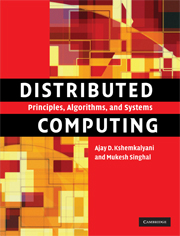Book contents
- Frontmatter
- Contents
- Preface
- 1 Introduction
- 2 A model of distributed computations
- 3 Logical time
- 4 Global state and snapshot recording algorithms
- 5 Terminology and basic algorithms
- 6 Message ordering and group communication
- 7 Termination detection
- 8 Reasoning with knowledge
- 9 Distributed mutual exclusion algorithms
- 10 Deadlock detection in distributed systems
- 11 Global predicate detection
- 12 Distributed shared memory
- 13 Checkpointing and rollback recovery
- 14 Consensus and agreement algorithms
- 15 Failure detectors
- 16 Authentication in distributed systems
- 17 Self-stabilization
- 18 Peer-to-peer computing and overlay graphs
- Index
16 - Authentication in distributed systems
Published online by Cambridge University Press: 05 June 2012
- Frontmatter
- Contents
- Preface
- 1 Introduction
- 2 A model of distributed computations
- 3 Logical time
- 4 Global state and snapshot recording algorithms
- 5 Terminology and basic algorithms
- 6 Message ordering and group communication
- 7 Termination detection
- 8 Reasoning with knowledge
- 9 Distributed mutual exclusion algorithms
- 10 Deadlock detection in distributed systems
- 11 Global predicate detection
- 12 Distributed shared memory
- 13 Checkpointing and rollback recovery
- 14 Consensus and agreement algorithms
- 15 Failure detectors
- 16 Authentication in distributed systems
- 17 Self-stabilization
- 18 Peer-to-peer computing and overlay graphs
- Index
Summary
Introduction
A fundamental concern in building a secure distributed system is the authentication of local and remote entities in the system. In a distributed system, the hosts communicate by sending and receiving messages over the network. Various resources (such as files and printers) distributed among the hosts are shared across the network in the form of network services provided by servers. The entities in a distributed system, such as users, clients, servers, and processes, are collectively referred to as principals. A distributed system is susceptible to a variety of threats mounted by intruders as well as legitimate users of the system.
In an environment where a principal can impersonate another principal, principals must adopt a mutually suspicious attitude toward one another and authentication becomes an important requirement. Authentication is a process by which one principal verifies the identity of another principal. For example, in a client–server system, the server may need to authenticate the client. Likewise, the client may want to authenticate the server so that it is assured that it is talking to the right entity. Authentication is needed for both authorization and accounting functions. In one-way authentication, only one principal verifies the identity of the other principal, while in mutual authentication both communicating principals verify each other's identity. A user gains access to a distributed system by logging on to a host in the system.
- Type
- Chapter
- Information
- Distributed ComputingPrinciples, Algorithms, and Systems, pp. 598 - 630Publisher: Cambridge University PressPrint publication year: 2008



